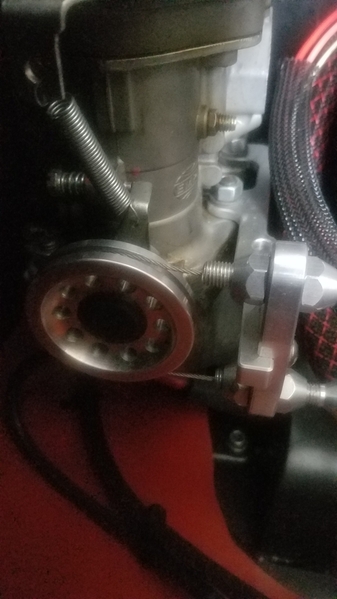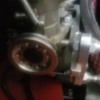So just for the Heckuvit, I bought a pair of CB Performance "Turbo Hats" for Pearl hoping for a two-part improvement:
1. Reduce intake noise a little for a quieter cockpit and;
2. Totally eliminate any chance of rain water getting in to the carburetors
They look pretty sharp in there - A nice, clean look and kinda "Factory":
So after messing with how they mounted and getting a bit of a spacer underneath to raise them a tad, I did a road test and they're all that and a bag of Tostitos. Very slightly quieter at low speeds and noticeably quieter with your foot way in it to open up the throats. Not a bad investment.
So with that done and just returning from a road test, I kinda-sorta wondered how close my Carbs were synced. The last time I bothered to sync them was when I got them back from Blackline Racing after their rebuild and they've been pretty close ever since with minimal fussing, mostly one air by-pass adjustment and idle twiddling.
So I looked at them and thought, "What Would @DannyP do?" and trudged into the shop to get my snail meter.
They were off.
Not a lot; a needle width difference between #3 & 4, and a needle width left to right at idle. Not bad, and easily twiddled. The I reconnected the linkage, ran it up to 3,000 rpm and held it with a special linkage tool I made to hold it running at any speed I want and rechecked it. I highly recommend wearing combat boots with heavy socks and a pair of long pants because after a couple of minutes of twiddling at 3 grand, your feet get really hot down there. Anyway:
Wow! One side was 12 and the other side was barely at 9! Twiddled the throttle adjustable link on the down side to bring it up and had to re-set it half a dozen times as each time I tightened the linkage locknuts it would change that side again. Finally figured it out and got everything synced and tight and the idle reset (twice) to boot. Success! totally synced and idling at about 800 rpm. Wrong time of day for a beer, so went inside and had a salad for lunch, instead.
Took it out for a road test and while it wasn't really that far out of sync before I started, you can really feel the difference in a much smoother engine at all rpms.
THAT's what Danny would do!
(Yeah, Danny.... I know, you're not surprised. I'm surprised that I had the patience to do it right (for a change)).





